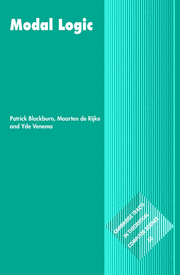Book contents
- Frontmatter
- Dedication
- Contents
- Preface
- 1 Basic Concepts
- 2 Models
- 3 Frames
- 4 Completeness
- 5 Algebras and General Frames
- 6 Computability and Complexity
- 7 Extended Modal Logic
- Appendix A A Logical Toolkit
- Appendix B An Algebraic Toolkit
- Appendix C A Computational Toolkit
- Appendix D A Guide to the Literature
- References
- List of Notation
- Index
Appendix B - An Algebraic Toolkit
Published online by Cambridge University Press: 05 July 2014
- Frontmatter
- Dedication
- Contents
- Preface
- 1 Basic Concepts
- 2 Models
- 3 Frames
- 4 Completeness
- 5 Algebras and General Frames
- 6 Computability and Complexity
- 7 Extended Modal Logic
- Appendix A A Logical Toolkit
- Appendix B An Algebraic Toolkit
- Appendix C A Computational Toolkit
- Appendix D A Guide to the Literature
- References
- List of Notation
- Index
Summary
In this appendix we review some basic (universal) algebraic notions used in Chapter 5. The first part deals with algebras and operations on (classes of) algebras, the second part is about algebraic model theory, and in the third part we discuss equational logic. Birkhoff's fundamental theorems are stated without proof.
For an introduction to universal algebra, see Burris and Sankappanavar [81] or Grätzer [198]; McKenzie, McNulty and Taylor [321] provide more comprehensive reading. Basic track readers may like the algebraic accounts of propositional logic given in Chapter 3 of Bell and Machover [32] and Chapters 1 and 2 of Bell and Slomson [33]. Many readers will find Davey and Priestly [105] useful supplementary reading.
Universal Algebra
An algebra is a set together with a collection of functions over the set; these functions are usually called operations. Algebras come in various similarity types, determined by the number and arity of the operations.
Definition B.1 (Similarity Type) An algebraic similarity type is an ordered pair ƒ = (F, ρ) where F is a non-empty set and ρ is a function F → ℕ. Elements of F are called function symbols; the function ρ assigns to each operator f ∈ F a finite arity or rank, indicating the number of arguments that f can be applied to.
- Type
- Chapter
- Information
- Modal Logic , pp. 497 - 503Publisher: Cambridge University PressPrint publication year: 2001



